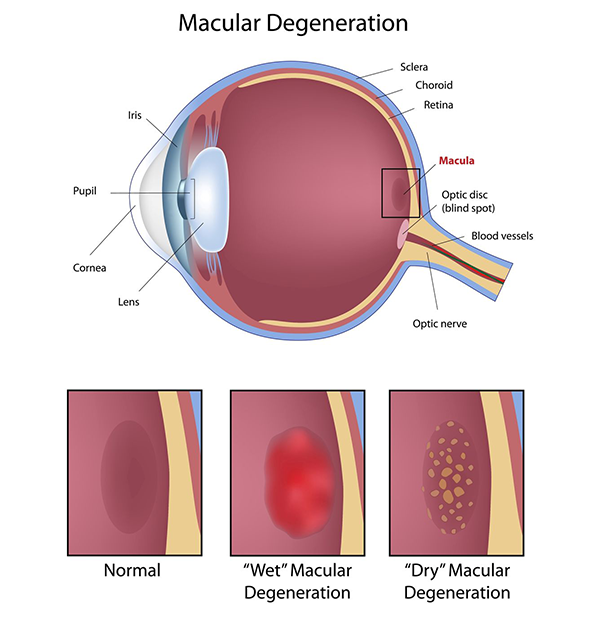

 The term “macular degeneration” includes many different eye diseases, all of which affect central, or detail vision. Age-related macular degeneration is the most common of these disorders, mainly affecting people over the age of 60. Although there are many types of macular degeneration, age-related macular degeneration (AMD or ARMD) is the most common type. Age-related macular degeneration occurs in two forms: “wet” age-related macular degeneration and “dry” age-related macular degeneration. “Wet” age-related macular degeneration is less common but more aggressive in its development to severe central vision loss. “Dry” age-related macular degeneration is the more common type and is more slowly progressive in causing loss of vision.
The term “macular degeneration” includes many different eye diseases, all of which affect central, or detail vision. Age-related macular degeneration is the most common of these disorders, mainly affecting people over the age of 60. Although there are many types of macular degeneration, age-related macular degeneration (AMD or ARMD) is the most common type. Age-related macular degeneration occurs in two forms: “wet” age-related macular degeneration and “dry” age-related macular degeneration. “Wet” age-related macular degeneration is less common but more aggressive in its development to severe central vision loss. “Dry” age-related macular degeneration is the more common type and is more slowly progressive in causing loss of vision.
Wet age-related macular degeneration occurs when abnormal blood vessels begin to grow underneath the retina. These new blood vessels (known as choroidal neovascularization or CNV) tend to be very fragile and often leak blood and fluid. The blood and fluid raise the macula from its normal place at the back of the eye and interfere with the retina’s function and causes the central vision to blur. Under these circumstances, vision loss may be rapid and severe. Some patients, however, do not notice visual changes despite the onset of CNV. Therefore, periodic eye examinations are very important for patients at risk for CNV. Once CNV has developed in one eye, whether there is a visual loss or not, the other eye is at relatively high risk for the same change.
In dry AMD, the light-sensitive cells in the macula slowly break down. With less of the macula functioning, central vision diminishes. Dry AMD often occurs in just one eye at first. Later, the other eye can be affected. The cause of dry AMD is unknown. The dry form is much more common than the wet form. Dry AMD can advance and cause vision loss without turning into wet AMD. Dry AMD can also rapidly transform into the wet form by the growth of new blood vessels.
We do not know the precise cause for the development of ARMD. However, we do know that there are certain risk factors for the development of age-related macular degeneration.
The greatest risk factor is age. Although AMD may occur during middle age, studies show that people over age 60 are clearly at greater risk than other age groups.
Neither dry nor wet AMD cause any eye pain. The most common early symptom in dry AMD is blurred vision. Dry macular degeneration symptoms usually develop gradually and do not include total blindness. However, the symptoms may worsen the quality of life by making reading, driving, and facial recognition difficult. Other symptoms may include decreased night vision, a decrease in the intensity or brightness of colors, increase in the haziness of overall vision. All of the above symptoms may also be noticed in the wet form of AMD. In addition, the most common symptom in wet macular degeneration is straight lines appearing crooked or wavy.
A thorough examination by an eye doctor is the best way to determine if you have macular degeneration or if you are at risk for developing the condition. The exam begins by testing your visual acuity or the sharpness of your vision. There are several different tests for visual acuity. The most familiar one has lines of black letters on a white chart. Next, your eyes may be tested with an Amsler grid. This test helps your doctor determine if you are experiencing areas of distorted or reduced vision, both common symptoms of macular degeneration. If you do have macular degeneration, your doctor will use the Amsler grid to determine if your vision has changed. After these visual tests, the front part of your eyes will be examined to determine if everything is healthy. Your doctor may put anesthetic drops in your eyes before measuring the pressure in each eye. Drops are also administered, which cause your pupils to dilate. This will allow your doctor to examine the retina through the enlarged pupil. After the dilating drops are administered and allowed time to work, the eye doctor will then use a slit-lamp to examine the eyes. The slit-lamp is a special microscope that enables the doctor to examine the different parts of the eye under magnification. When used with handheld lenses or special contact lenses, the slit-lamp gives the examiner a highly magnified view of the retina.
Wet AMD can be treated with laser surgery, photodynamic therapy, and injections into the eye. None of these treatments is a permanent cure for wet AMD. The disease and loss of vision may continue to grow despite treatment.
There is currently no treatment available to reverse dry macular degeneration. However, dry macular degeneration usually develops at a slower pace and most patients with this condition are able to live relatively normal, productive lives. Often one eye is affected more than the other.
Your lifestyle can play a role in reducing your risk of developing AMD. This includes:
Optometrist Website Design | Accessibility Policy